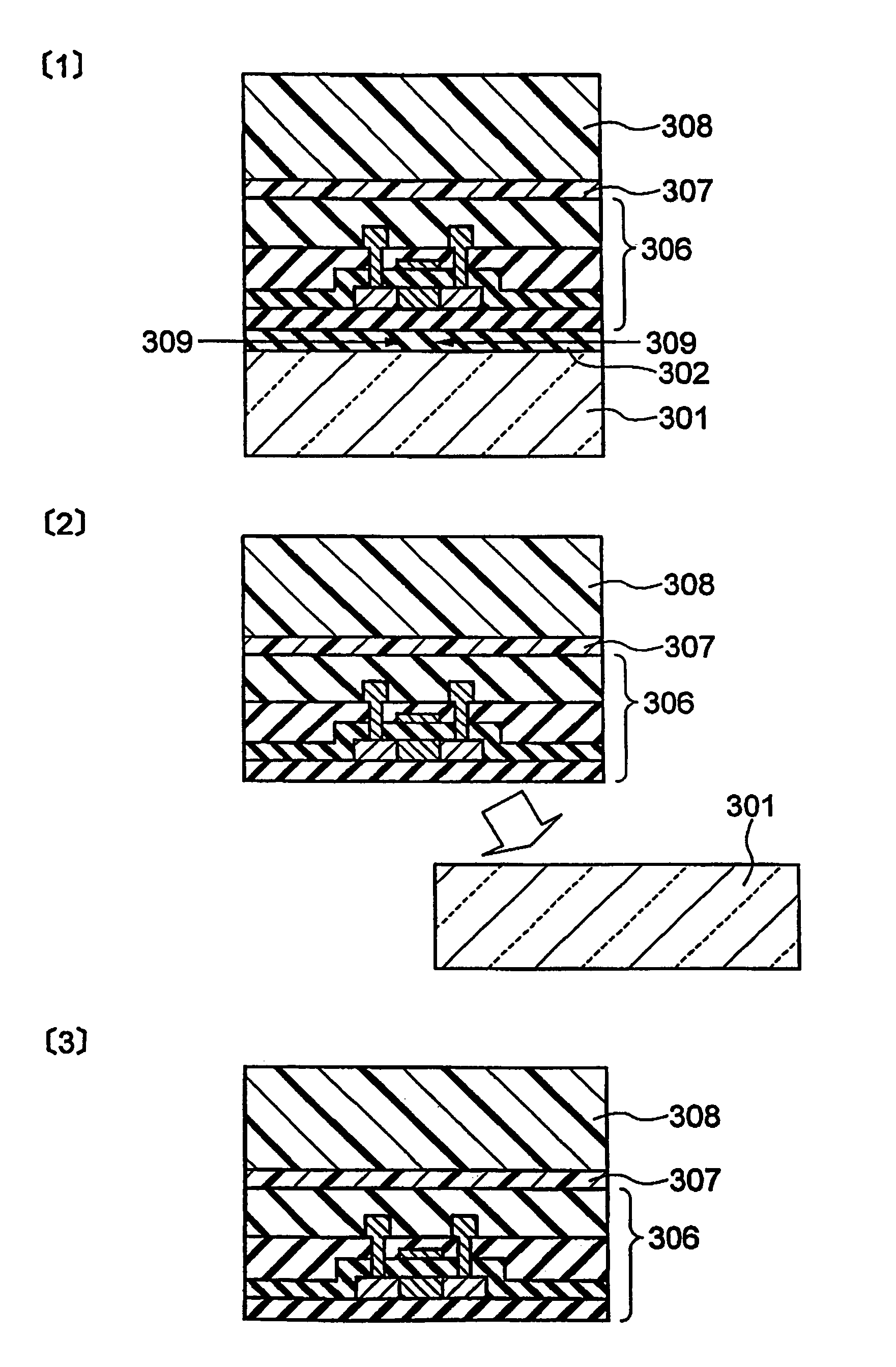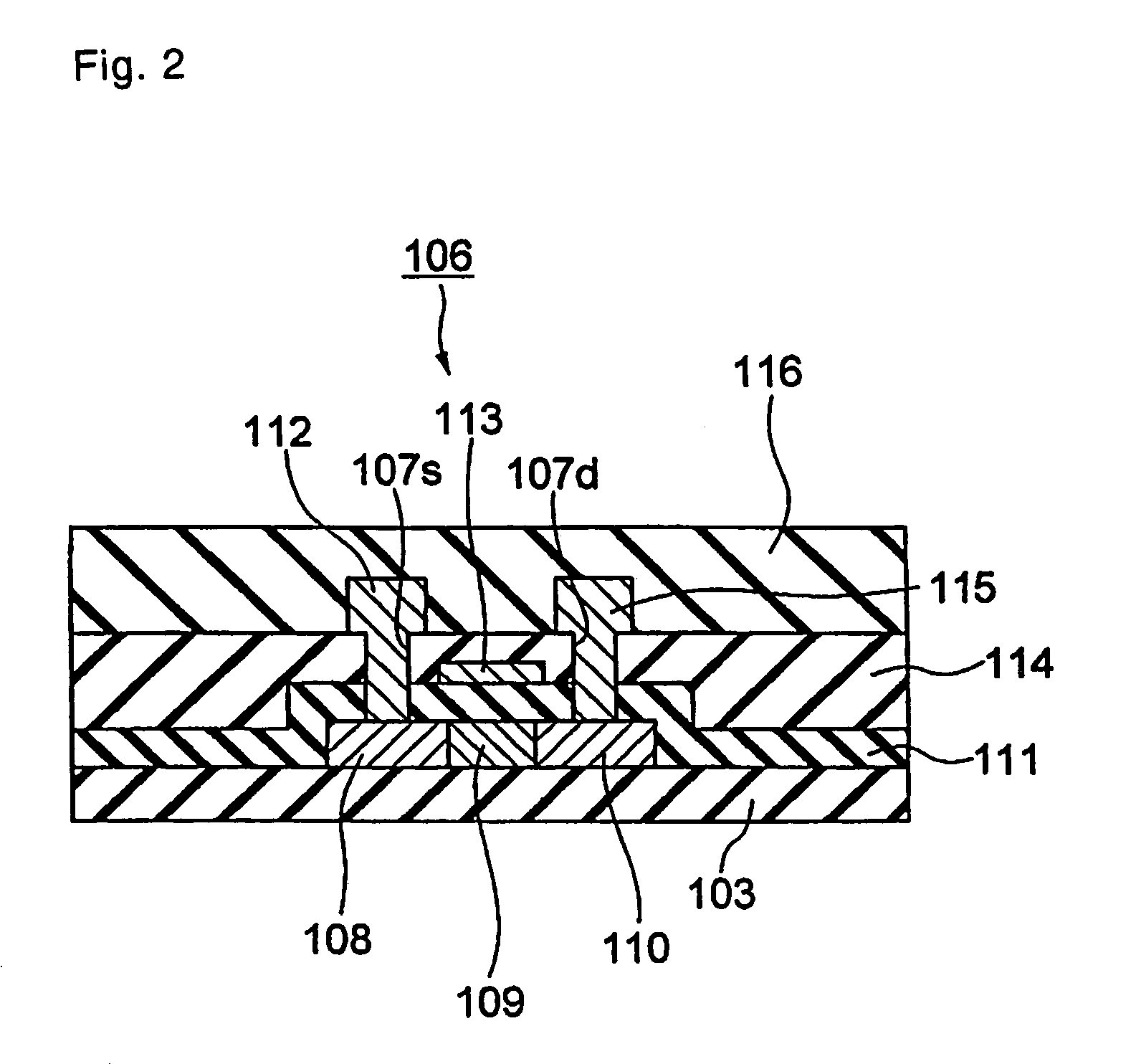Manufacturing method of thin film device substrate
a manufacturing method and thin film technology, applied in the direction of semiconductor devices, electrical devices, transistors, etc., can solve the problems of insulating film preventing the diffusion of heat generated by tft operation, etc., to achieve the effect of improving the mechanical strength of the thin film device substrate, preventing abnormal operations caused by overheating of the thin film device, and reducing the cost of production
- Summary
- Abstract
- Description
- Claims
- Application Information
AI Technical Summary
Benefits of technology
Problems solved by technology
Method used
Image
Examples
first example
[0074]FIGS. 4 and 5 are a series of schematic cross-sectional views illustrating Example 1 of the present invention. The steps of a manufacturing method thereof proceed in the order of FIG. 4(1), FIG. 4(2), FIG. 4(3), FIG. 4(4), FIG. 5(1), FIG. 5(2) and FIG. 5(3). Referring to these drawings, the embodiment of the present invention is described below.
[0075]Firstly, as shown in FIG. 4(1), on a glass substrate 301, a porous silicon oxide film 302 is formed by the spin coating method as a heat insulating film, and on the porous silicon oxide film 302 a silicon oxide film 303 is formed, and then an amorphous silicon oxide film 304 is formed by the LPCVD (Low Pressure Chemical Vapor Deposition) method. A liquid used in this spin coating method is, for example, a solution of silanol-based monomers or oligomers dissolved in an organic solvent such as alcohol or ketone or a solution in which fine powders of silicon oxide are dispersed and suspended in an organic solvent. By dropping the liq...
second example
[0079]FIGS. 6 and 7 are a series of schematic cross-sectional views illustrating Example 2 of the present invention. The steps of a manufacturing method thereof proceed in the order of FIG. 6(1), FIG. 6(2), FIG. 6(3), FIG. 6(4), FIG. 7(1), FIG. 7(2) and FIG. 7(3). Referring to these drawings, the embodiment of the present invention is described below.
[0080]As shown in FIG. 6(1), on a glass substrate 401, a chromium film 401′ is first formed as a peeling-off film, for example, by the sputtering method, and on the chromium film 401′ a porous silicon oxide film 402 is formed as a heat insulating film by the spin coating method, and, then, on the porous silicon oxide film 402 a silicon oxide film 403 is formed by the plasma CVD method, and thereon an amorphous silicon film 404 is further formed by the thermal CVD method. Following that, as shown in FIG. 6(2), the amorphous silicon film 404 is irradiated from above with a laser beam 405 of an excimer laser to obtain a polycrystalline sil...
third example
[0083]FIGS. 8-17 are sets of schematic views illustrating Example 3 of the present invention, each set showing a plan view and one or two cross-sectional views. The steps of a manufacturing method thereof proceeds in the order of FIG. 8, FIG. 9, FIG. 10, FIG. 11, FIG. 12, FIG. 13, FIG. 14, FIG. 15, FIG. 16 and FIG. 17. Referring to these drawings, the embodiment of the present invention is described below.
[0084]Firstly, as shown in FIG. 8, on a glass substrate 501, a silicon oxide film 502, a silicon nitride film 503 and an amorphous silicon oxide film 504 are successively formed in this order. The silicon nitride film 503 is formed by the PECVD (Plasma-Enhanced CVD) method. In this instance, hydrogen is fed into the CV chamber as a source gas, whereby a silicon nitride film containing a considerable amount of hydrogen is formed. In this way, the etching rate of silicon nitride by hydrofluoric acid can be made very small in comparison with that of silicon oxide.
[0085]Next, as shown ...
PUM
| Property | Measurement | Unit |
|---|---|---|
| temperature | aaaaa | aaaaa |
| heat | aaaaa | aaaaa |
| heat insulating | aaaaa | aaaaa |
Abstract
Description
Claims
Application Information
 Login to View More
Login to View More - R&D
- Intellectual Property
- Life Sciences
- Materials
- Tech Scout
- Unparalleled Data Quality
- Higher Quality Content
- 60% Fewer Hallucinations
Browse by: Latest US Patents, China's latest patents, Technical Efficacy Thesaurus, Application Domain, Technology Topic, Popular Technical Reports.
© 2025 PatSnap. All rights reserved.Legal|Privacy policy|Modern Slavery Act Transparency Statement|Sitemap|About US| Contact US: help@patsnap.com



